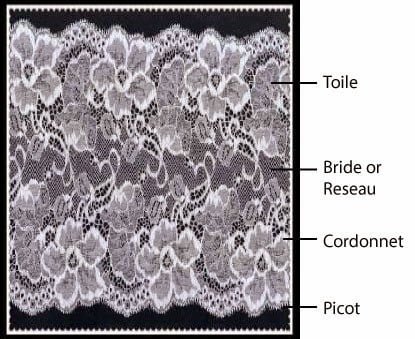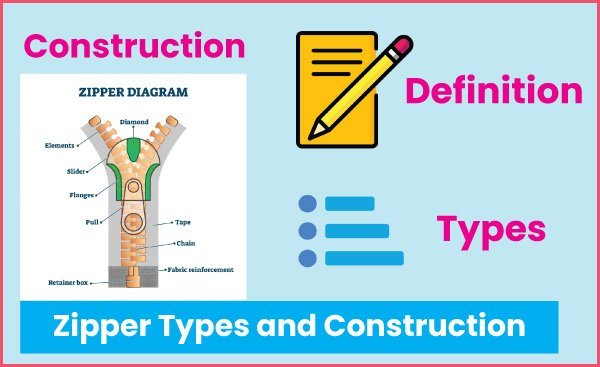What is Lace Fabric | Parts of Lace Construction | Uses and Types of Lace
Last updated on December 20th, 2023 at 03:07 pm
Definition
Lace is an open work fabric consisting of a network of yarns formed into intricate designs. Lace may be hand or machine made, and intricate patterns can be produced by either technique. Both narrow and wide lace fabrics are available. The edges of the fabric may be straight or curved.
It is an important trimming, for it is used for table cloths, curtains, handkerchiefs, dresses and underwear.

Parts of Lace Construction
In identifying various kinds of lace, references have been made to their designs. These patterns are constructed of different parts, each having a particular designation.

Bride or Reseau
It is the fine yarn that forms the mesh which provides the sheer ground (background) between the prominent parts of the pattern.
Cordonnet
It is the heavy yarn that outlines the pattern.
Picot
It is a decorative loop used both in the pattern and on the edge of the lace.
Toile
It represents the predominant parts of the pattern made by braiding, knotting, looping, or twisting the yarn.
Uses of Laces
Lace is a decorative fabric used in apparel and home furnishings. Narrow laces are used for trims and insertions; wide lace fabrics are used for curtains, table cloths, and garments.
Laces are made in different widths for different uses. For example, a narrow lace with a scalloped edge is used for trimming a baby’s dress; a lace with slits or eyelets is so made that ribbon may be run through it.
All-over laces
An all over lace is a fabric up to 36” width with the design or pattern spread over the width of the fabric and repeated in its length. Many kinds of design motifs and colors are used. The fabric can be produced in widths of over one yard (1m) that are devoid of scallops. The fabric is cut and solid from the bolt like woven dress goods. The dressmaker cuts it to pattern and makes it up into formal evening, dinner, and cocktail dress and blouses.
Flouncing
Flouncing applies to laces18 to 36 inches wide with a plain edge at the top and a scalloped edge at the bottom of the fabric. It is used for wide ruffles or flounces. Often these flounces are arranged in tiers to form a skirt.
Gallon
A galloon is a lace up to 18 inches wide with a scalloped edge at top and bottom. It may be used as an insertion between two cut edges of fabric.
Insertion
Insertion is a band of lace sewn between two pieces of fabric or on a single piece of fabric at the straight top or bottom edges. A variety of insertion is footing, which has a straight edge at top and bottom but no patterns. Footing is often used at the bodice or at the bottom hem of a slip.
Beading
Beading has slots through which ribbon may be run. These slots may be found in edgings or galloons but are much more common in insertions.
Edging
An edging is a lace never more than 18” wide that is straight at the top and scalloped at the bottom. It is sewn to the edge of a dress, gown, blouse, handkerchief, or lingerie.
Medallion
A medallion is a lace in a single design that can be appliquéd to a fabric ground for ornamentation. It is sometimes used in the corners of napkins, or towels or as an ornament for a dress, blouse or lingerie.
Types of Lace
The two main types of laces are real or handmade or machine made. Linen thread is usually used for real lace and also expensive laces, but cotton, rayon, nylon, silk or other yarns are now used for various qualities and types and for machine lace.
Handmade Lace or Real Lace
Bobbin lace
Sometimes called pillow lace, the lace design is drawn either on pillow or on a paper that is placed over the pillow. Small pegs or pins are stuck into the pillow along the design, and a large number of small bobbins of thread are manipulated around the pegs or pins to produce the lace. A number of threads, each on its own bobbin, are interlaced by twisting and plaiting around the pins to produce the motif in a mesh construction. As the lace is completed, the pins are pulled out and the lace is removed from the pillow. Making pillow lace requires great skill and dexterity, for as many as three hundred bobbins may be needed to make some patterns.
Darned lace
It has a design darned by a chain stitch onto a mesh background. When made by hand, the design of darned lace is sewn with thread and needle passed in and out of a mesh net. There are two principal types of darned lace-
Antique lace – Has a darned lace pattern on a rectangular mesh ground.
Filet lace – Has a darned lace design on a square mesh ground.
Needle point lace
The design for needle point is drawn on parchment stitched to a backing of stout linen, and the lace is made by filling in the pattern with button hole stitches. When the lace is completed, the parchment is removed. Needle point lace is made entirely with a sewing needle and thread. A design is drawn on paper, thread is laid over the design, and the thread is then sewn in place with button hole and blanket stitches.
Crochet lace
When handmade, this is made with a crochet hook, to form a series of loops, each one of which is finished with a fine stitch, working usually with specially twisted cotton thread. It originated in Ireland as an imitation of Venetian needle point. It is a comparatively inexpensive heavy lace. Irish crocheted lace is typified by a rose or shamrock design that stands out from the background.
Tatting lace or Knotted lace
This is made by twisting and knotting thread by means of a small shuttle. When made by pass in a shuttle in and out of loops in a thread, it is called tatting. It is identified by a circle like motif and picots around the edges of the motif. Clover leaf and wheel designs are the most popular, but other patterns are also made.
Machine Made Lace
Nearly all the laces classified as real laces can be duplicated by machine with slight variations and simplifications.
Leavers lace
The leavers lace machine can produce the most intricate patterns from any type of yarn into fabrics up to ten yards wide. It is huge, complex machine that takes an operator two to three weeks to thread. Very thin, round, brass bobbins containing up to 300 yds each are individually conveyed by carriages moving back and forth from one warp to another. As each bobbin is moved to a predetermined position, it swings between the warp yarns and wraps its yarn around one warp before it is moved to another. Since there are about 20 bobbins per inch, very intricate designs are possible. The fabrics can be fairly expensive. Leavers lace is used to a great extent in the dress industry.
Nottingham Lace
The Nottingham machine originated in Nottingham, England. It also utilizes swinging brass bobbins but produces a flat lace that is coarser than leavers lace. Its large overall patterns are used for such purposes as table cloths.
Bobbin lace
The bobbin machine employs the braiding principle. The lace produced has a fairly heavy texture, with an angular appearance and a uniform count. Bobbin lace lacks the fine texture and flowing lines of the laces produced by other machines.
Raschel lace
Knitting machines can be constructed to make lace resembling levers and crocheted laces. The Raschel machine, which has its needles set horizontally instead of vertically as for knitting, can produce at high speed inexpensive lace fabrics of man-made filament yarns.
Ratine lace
It is a machine made lace that has a ground of heavy loops resembling that of terry cloth.
You may also like: 10 Types of Curtain Fabrics To Match Your Curtain




Just awesome.
I learned SO much from your post. THANK YOU for taking the time to share your knowledge!
You are most welcome…
please try to add pictures of different kinds of laces along with the information that you have shared here above, which will infact help your readers to understand even better.
Try to post pictures with the explanation you have given in this, as this will help you readers relate and understand better.
Thanks for your suggestion…
Basic ideas about laceThanks
This is better info than I’ve found anywhere else.
You’ve been great to me. Thank you!
It’s nice to read good comments. It makes it much more enjoyable!
Thank you for your articles. They are very helpful to me. Can you help me with something?